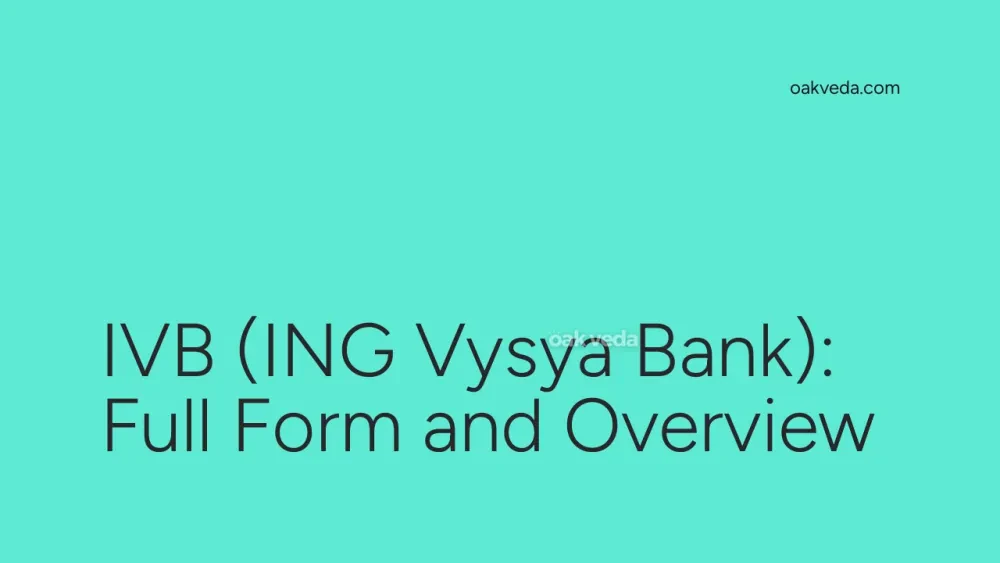
What is the Full Form of IVB?
The full form of IVB is ING Vysya Bank. This privately owned, Bangalore-based Indian multinational bank was a significant player in the country's financial sector, offering a wide range of retail, wholesale, and private financial services.
What is ING Vysya Bank?
ING Vysya Bank was a unique entity in the Indian banking landscape, formed as a result of the merger between the Dutch ING Group and the local Vysya Bank in 2002. This merger marked a significant milestone as it was the first of its kind between an Indian bank and a foreign bank in the country.
Origin and Development of ING Vysya Bank
The origins of ING Vysya Bank can be traced back to the early 2000s when the Dutch ING Group acquired equity stakes in Vysya Bank. This acquisition was preceded by a seven-year strategic partnership and shareholding agreement between Vysya Bank and the Belgian bank Banque Bruxelles Lambert, which ING Group had purchased in 1998.
The merger brought together the local expertise of Vysya Bank, which had been serving Indian customers for decades, with the global financial acumen of the ING Group. This combination created a powerful entity capable of competing effectively in the Indian banking sector.
How did ING Vysya Bank work?
ING Vysya Bank operated on a multi-faceted model, catering to various segments of the Indian financial market. The bank's operations were structured into three strategic business units:
- Private Banking
- Retail Banking
- Wholesale Banking
This structure allowed the bank to provide tailored services to different customer segments, from individual retail clients to large corporate entities.
Functions of ING Vysya Bank
ING Vysya Bank offered a comprehensive range of financial services and products, leveraging its extensive network and technological capabilities. Some of the key functions included:
1. Private Banking
- Operated on an advisory-driven model
- Focused on advanced market analysis
- Launched targeted products for high-end private banking sector
2. Retail Banking
- Provided savings deposits and checking accounts
- Offered consumer loans and wealth management services
- Managed rural and agricultural banking operations
- Distributed retail life insurance products
3. Wholesale Banking
- Offered financial, transactional, and electronic banking products to corporate customers
- Provided customer-focused solutions such as capital expenditure financing
- Managed foreign exchange services and cash management solutions
4. Agriculture and Rural Banking
- Supported agricultural and allied businesses
- Offered gold loans and Self-Help Group (SHG) loans
- Provided working capital and term funding for various agricultural sectors
Applications of ING Vysya Bank Services
ING Vysya Bank's services found applications across various sectors of the Indian economy:
- Personal Finance: Retail customers benefited from savings accounts, loans, and wealth management services.
- Corporate Banking: Large businesses utilized the bank's wholesale banking services for their financial needs.
- Agricultural Sector: Farmers and rural businesses accessed specialized financial products tailored to their unique requirements.
- Small and Medium Enterprises (SMEs): The bank provided crucial financial support to SMEs, contributing to their growth and development.
Features of ING Vysya Bank
ING Vysya Bank was known for several distinctive features:
- Extensive Network: The bank operated 547 branches, 10 counters, 28 satellite offices, and 470 ATMs nationwide.
- Technological Integration: Leveraged advanced technology for efficient service delivery.
- Customer-Centric Approach: Focused on developing products and services tailored to specific customer needs.
- Global Expertise: Combined local knowledge with international banking practices.
Benefits of ING Vysya Bank
The bank offered numerous benefits to its customers and the Indian banking sector:
- Diverse Product Portfolio: Catered to a wide range of financial needs under one roof.
- International Banking Standards: Brought global best practices to the Indian market.
- Specialized Services: Offered expert advisory services in private banking.
- Rural Focus: Contributed to financial inclusion by serving agricultural and rural sectors.
Limitations or Challenges of ING Vysya Bank
Despite its strengths, ING Vysya Bank faced certain challenges:
- Competition: Intense competition from larger public sector banks and emerging private banks.
- Regulatory Environment: Navigating the complex and evolving regulatory landscape in India.
- Technology Adoption: Keeping pace with rapid technological advancements in the banking sector.
Future Developments in ING Vysya Bank
In a significant development, ING Vysya Bank merged with Kotak Mahindra Bank in 2015. This merger created one of India's largest private sector banks, combining ING Vysya's strengths with Kotak Mahindra's robust banking infrastructure.
FAQs on IVB Full Form
-
What is the full form of IVB? The full form of IVB is ING Vysya Bank.
-
When was ING Vysya Bank established? ING Vysya Bank was formed in 2002 through a merger between ING Group and Vysya Bank.
-
What happened to ING Vysya Bank? In 2015, ING Vysya Bank merged with Kotak Mahindra Bank.
-
What types of banking services did IVB offer? IVB offered private, retail, and wholesale banking services, along with specialized agricultural and rural banking solutions.
-
Was ING Vysya Bank a public or private sector bank? ING Vysya Bank was a private sector bank.
In conclusion, ING Vysya Bank, the full form of IVB, played a significant role in shaping the Indian banking landscape. Its unique blend of international expertise and local knowledge set new standards in the industry, paving the way for future innovations in banking services.
You may be interested in:

